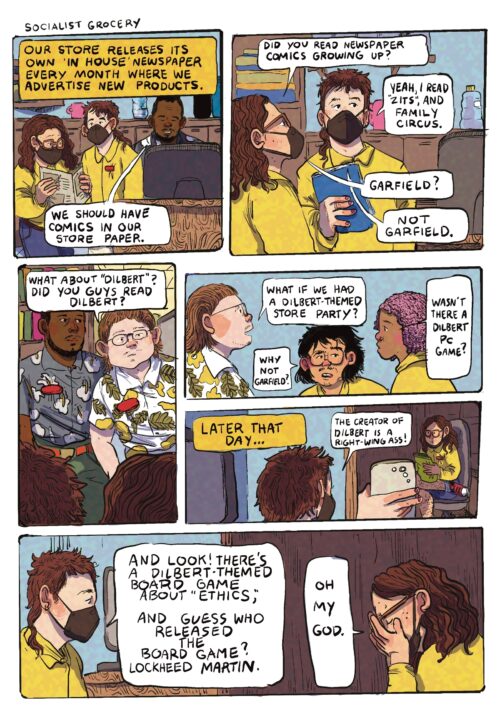Post by Cate Fallon
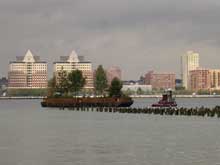
[Ed. note: Last Friday, Libby and I and my New Orleans friends Chuck and Iris drove to New York for the press preview of the Robert Smithson “Floating Island,” a realization of a Smithson proposal that never saw daylight during the artist’s lifetime. Cate was to meet us there. Traffic on the NJ Turnpike was snarled by an accident that forced us off and into the back roads of the garden state with all the trucks and SUVs and we arrived in New York too late for the preview speeches and fanfare. All in all, we caught glimpses of the little floating barge of willow trees and shrubs and loved it and its wee tugboat. What follows is Cate’s report on the press preview and her photos of the Floating Island.]
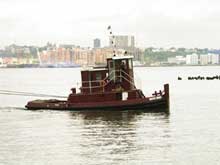
The whole event was very sweet — and in an improbable way, all the people who spoke that morning said they were surprised that Smithson who is known for his massive work would have had this little gem waiting in the wings — it had been a real surprise to them all. The scale and fragility of the piece seemed to connect them all to the piece in a way that they had not expected — more like adoptive parents than authoritative curators of ART (or landscape architects).
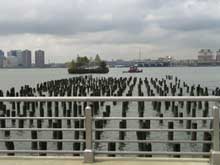
They talked about the issue of a changing world — how today, New York is embracing its harbor and shoreline. And 25 years ago it was a working neighborhood filled with trucks and some artists on the fringe – not today’s boutiques and environmentally-enhanced bikepaths and runner/walker/stroller paths.
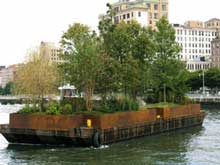
The current rehab of the harbor was one part of the reason that it now became feasible to propose and get the funding to do a project that Smithson could not fund 30+ years ago. It now references a city or time past. Would the tug look so “cute?” Would anyone other than a truck driver see or notice it? Would it just be an absurdity?
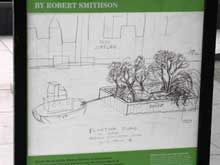
The island was constructed from his notes and the drawing. It has stone from Central Park (a constructed landscape that Smithson frequently visited and referenced). And the trees are indigenous — all the trees and rocks will return to Central Park at the end — return to the mother ship? Prodigal rock and tree?
No — just something from this time about that time and for the future time.
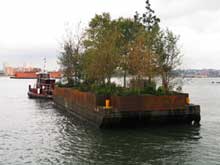
There is a path on the island — a path no one walks on — a path of possibility — a walk in the offing — not yet taken.
They talked about the issue of time — how the trees had been planted just a short time ago and were already losing some leaves. Yes, it was fall, but it was also nature and natural for them to grow and change.
There was much back-slapping and glad-handing over how well they had all worked together and how in an odd effortless way, the piece had just come together.
CONCERNS
Not rain — rain is good for trees.
Wind — anything over 25mph would cause stability problems.
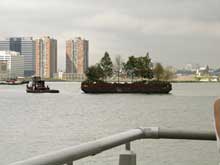
The barge is docked overnight in Staten Island and the tugboat captain is the watchman and guardian of the night. They will sail around Manhattan, an island itself, about 1.5 times a day. They can only get up the East River (east side of Manhattan) to about 23rd Street due to the United Nations being in session, although most of the world luminaries, if they saw it, would rather appreciate it for its care of resources and homage to nature.
Minetta Brook is the name of a stream that flows under lower Manhattan so the group took its name Minetta Brook because of its interest in the river/harbor etc. of the city. The woman (Diane Shamash) was instrumental in getting the people and funding together.
The Whitney Museum sponsored the project as part of its Smithson Retrospective.
also:
ROBERT SMITHSON SYMPOSIUM
Saturday, September 24
11am-6pm
Kaye Playhouse at Hunter College
East 68th Street between Park & Lexington Avenues Entrance is closer to Lexington, on the North side of 68th St.
Admission is free, but registration is required. Please call (212) 570-7715, or e-mail public_programs@whitney.org to specify a session or sessions. Seats will be available on a first-come, first-served basis. See here for more information about the seminar options.
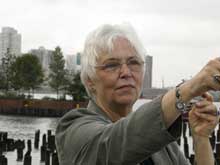
Someone in my class (Cate teaches photography at NYU) said it was sort of like The Gates — hard to really see, hard to really get, a little underwhelming, but such an event. One person who hadn’t known about it saw it and thought — how odd.
The picture of the woman — Nancy Holt (Smithson’s widow) is pointing at the old house they lived in on the west side around when he did the drawing.
–Cate Fallon is a photographer living in New York.






